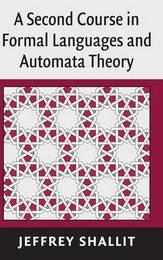
|
A Second Course in Formal Languages and Automata Theory
Hardback
Main Details
| Title |
A Second Course in Formal Languages and Automata Theory
|
| Authors and Contributors |
By (author) Jeffrey Shallit
|
| Physical Properties |
| Format:Hardback | | Pages:254 | | Dimensions(mm): Height 229,Width 157 |
|
| Category/Genre | Mathematical theory of computation |
|---|
| ISBN/Barcode |
9780521865722
|
| Classifications | Dewey:005.131 |
|---|
| Audience | | Tertiary Education (US: College) | |
|---|
| Illustrations |
Worked examples or Exercises; 12 Tables, unspecified
|
|
Publishing Details |
| Publisher |
Cambridge University Press
|
| Imprint |
Cambridge University Press
|
| Publication Date |
8 September 2008 |
| Publication Country |
United Kingdom
|
Description
Written for graduate students and advanced undergraduates in computer science, A Second Course in Formal Languages and Automata Theory treats topics in the theory of computation not usually covered in a first course. After a review of basic concepts, the book covers combinatorics on words, regular languages, context-free languages, parsing and recognition, Turing machines, and other language classes. Many topics often absent from other textbooks, such as repetitions in words, state complexity, the interchange lemma, 2DPDAs, and the incompressibility method, are covered here. The author places particular emphasis on the resources needed to represent certain languages. The book also includes a diverse collection of more than 200 exercises, suggestions for term projects, and research problems that remain open.
Author Biography
Jeffrey Shallit is Professor of the David R. Cheriton School of Computer Science at the University of Waterloo. He is the author of Algorithmic Number Theory (co-authored with Eric Bach) and Automatic Sequences: Theory, Applications, Generalizations (co-authored with Jean-Paul Allouche). He has published approximately 90 articles on number theory, algebra, automata theory, complexity theory, and the history of mathematics and computing.
Reviews'First courses in automata theory are now essential for both mathematicians and computer scientists, and there are some fine books from which one can learn the basics. But the question is: what next? ... There is ... a niche for second courses on automata theory that point the way to future study in the field without bludgeoning the reader under the weight of pages. At a shade under 250 pages Jeffrey Shallit's book is just such a second course. ... The writing is crisp and no nonsense ... Shallit has written a mathematically rigorous book that has avoided the pitfall of being unduly fussy.' SIAM Review
|